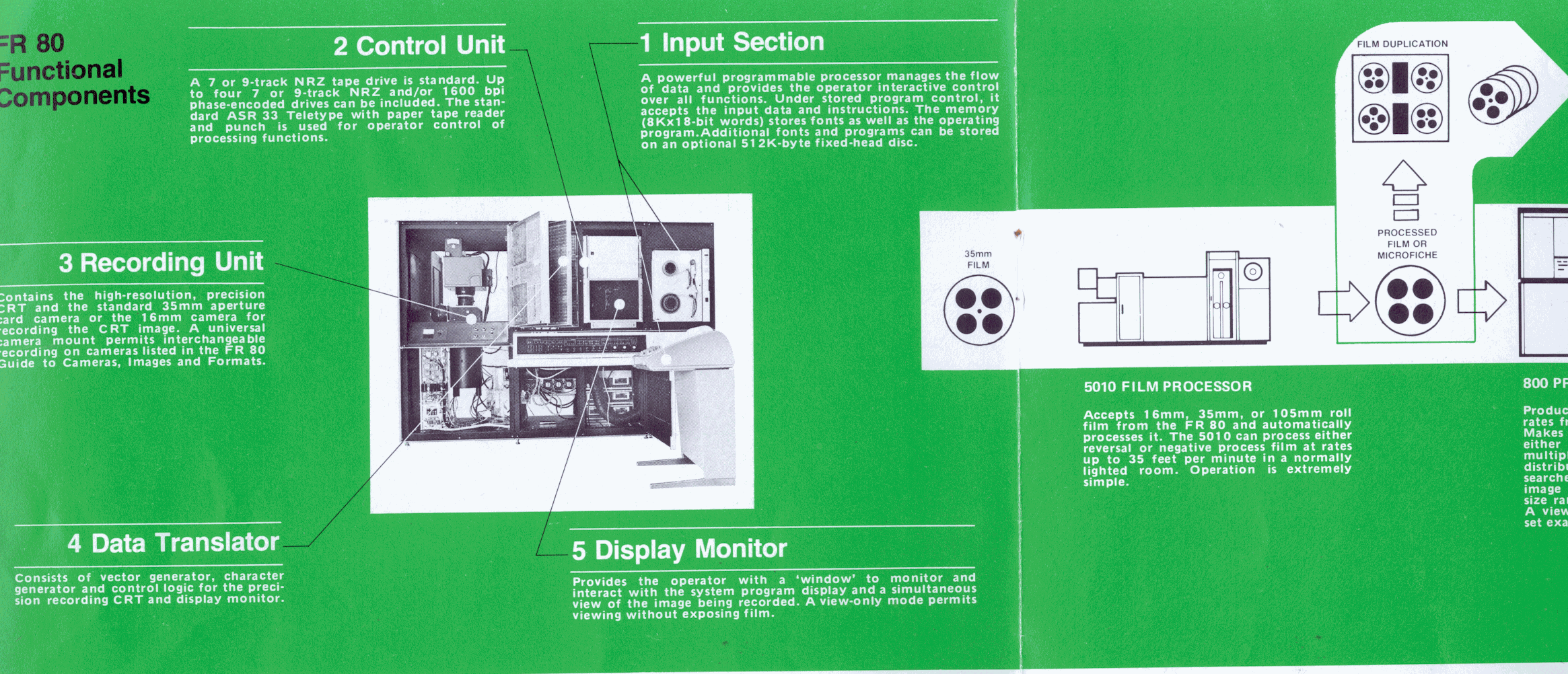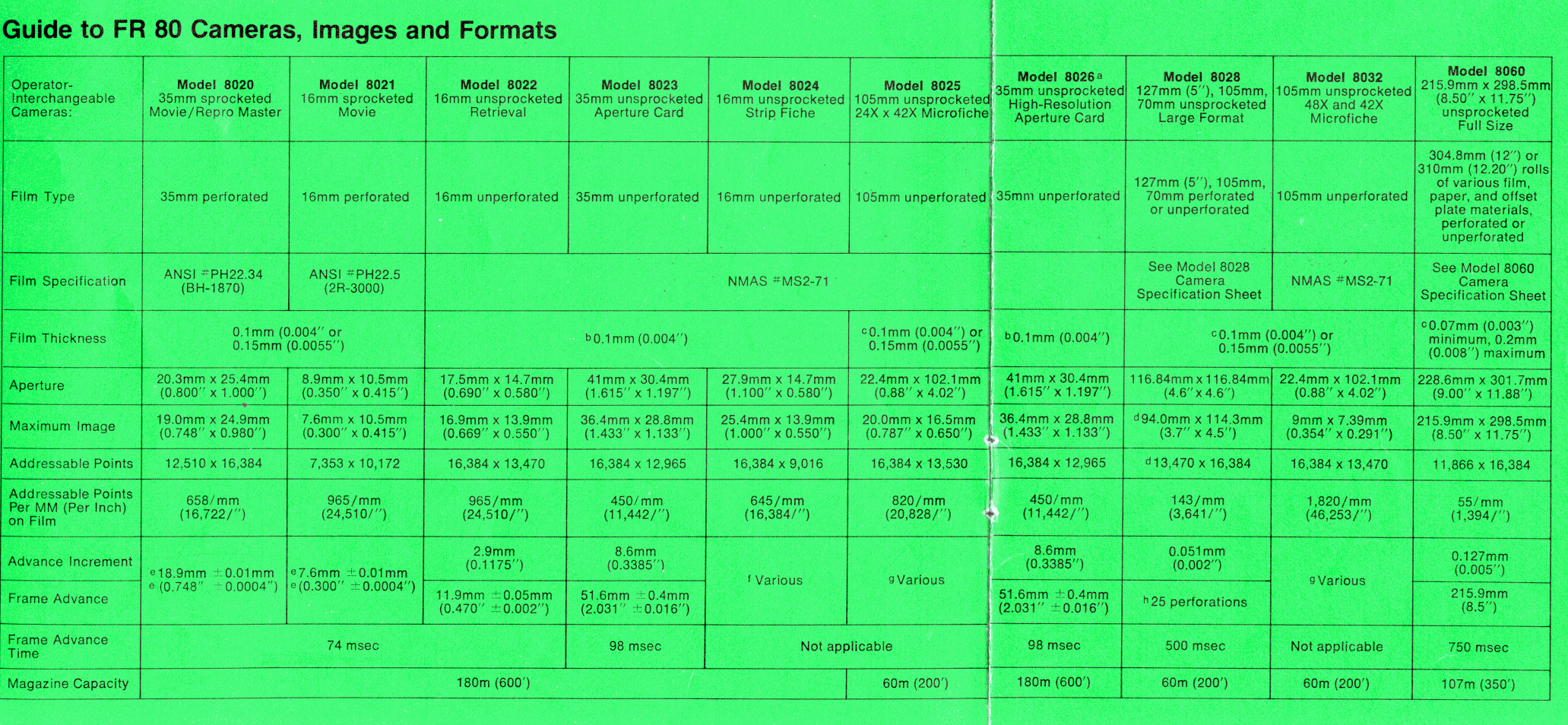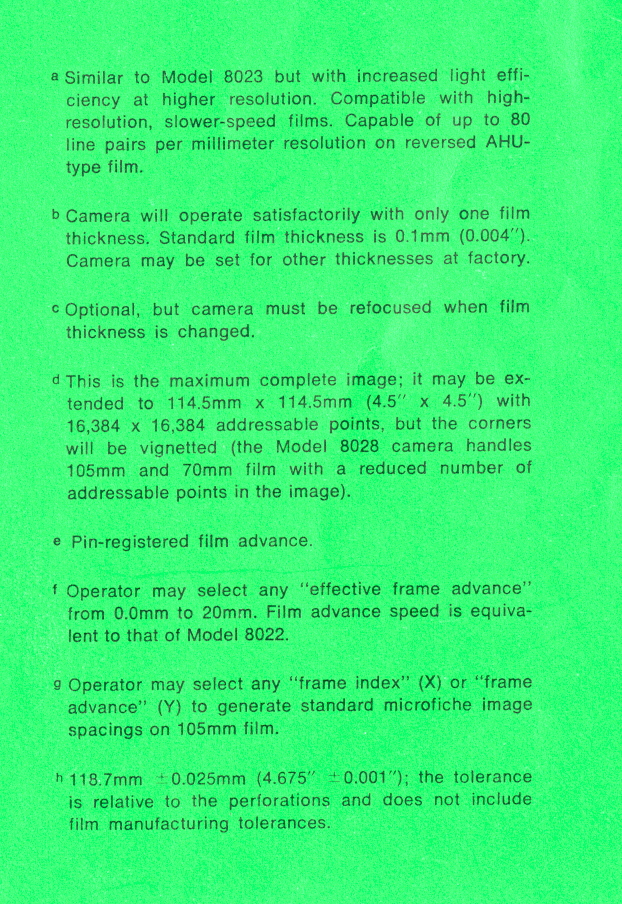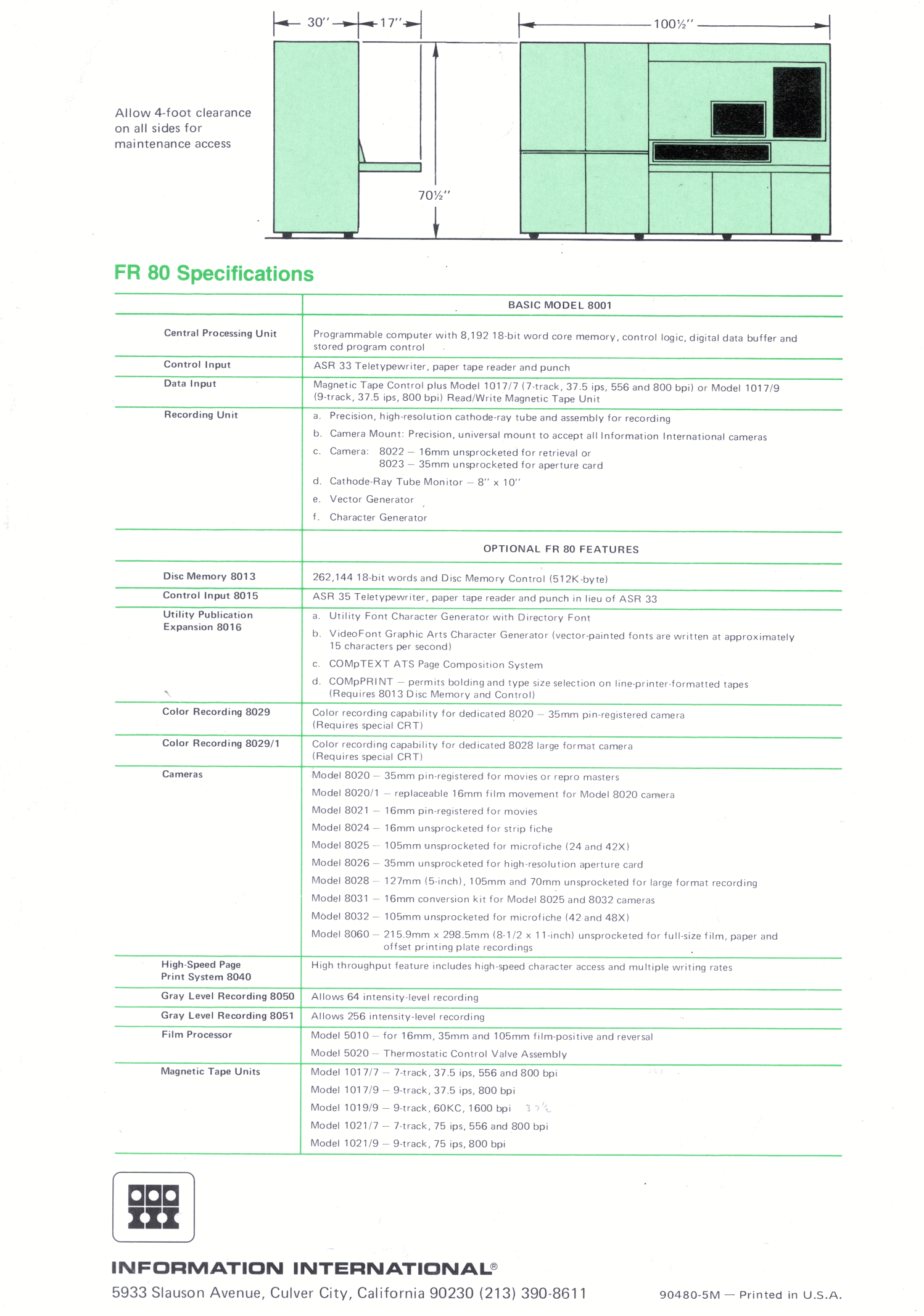

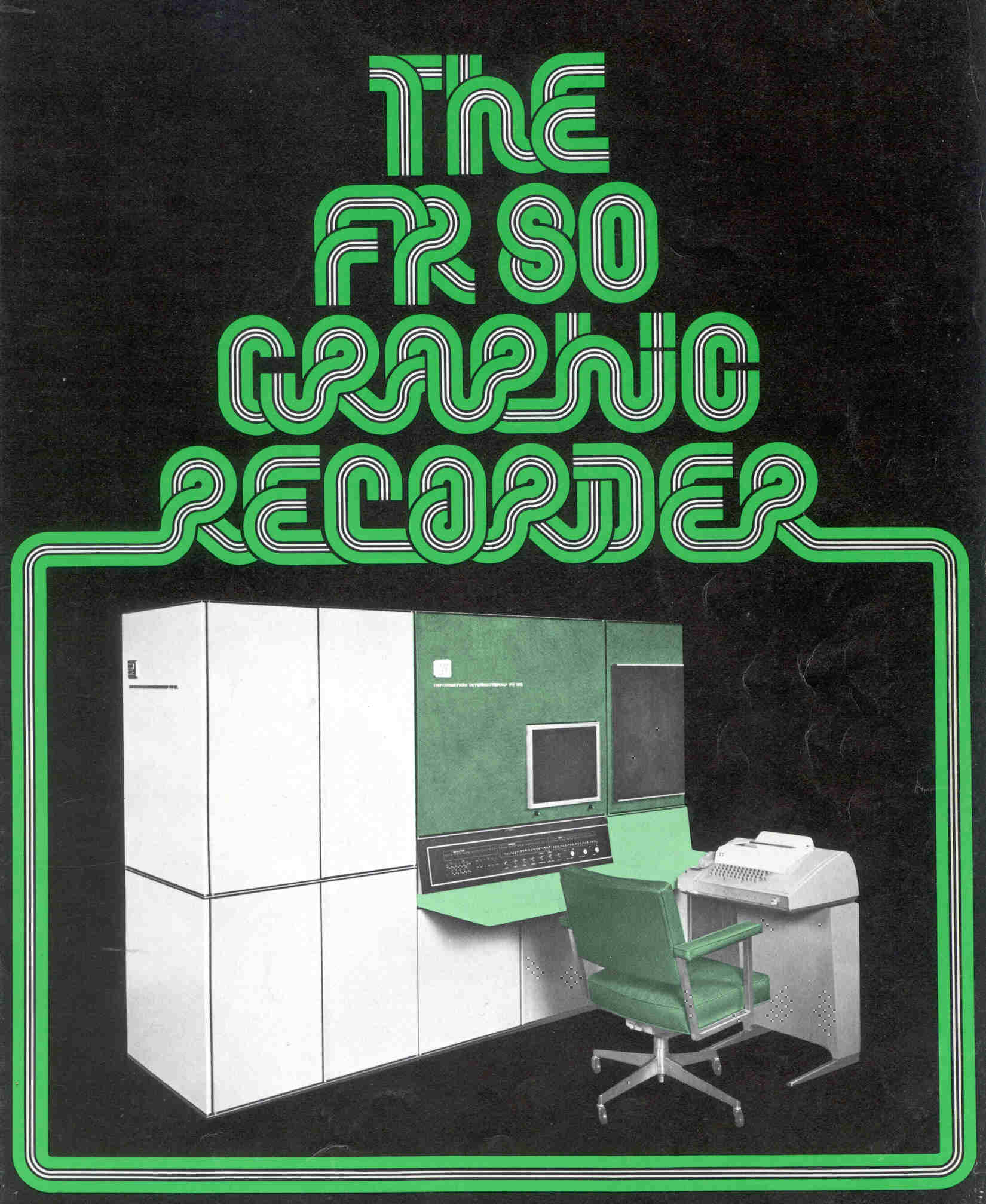
The Information International FR 80 is a general-purpose, precision recorder with the ability to handle a wide range of alphanumeric and graphic applications that demand high quality and high speed microfilm output. It is designed to automate applications where turnaround time is in direct proportion to the effectiveness of the information; where legibility, image quality and precision is crucial to the end product or result. The FR 80 relieves host computers of the costly and time-consuming burden of generating computer printout or reformatting data for other output devices.
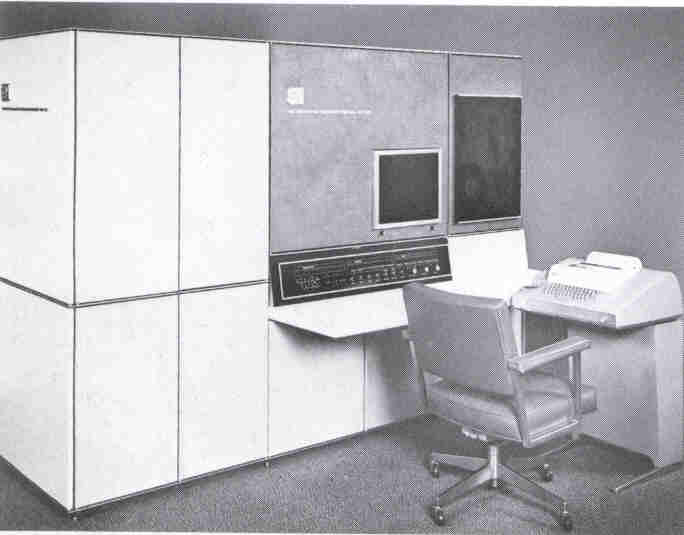
Besides its own native data format, the FR 80 accepts tapes formatted for a broad range of other COM, line printer, and plotter output devices. This allows the user his option of input format. The FR 80 consists of a high-speed computer that accepts digital data from magnetic tape, a translator to process the data and a precision electro-optical system that records data as alphanumeric and/or graphic information on a high-resolution CRT. Interchangeable camera systems photograph the face of the CRT and record it on a variety of output materials. Precision resolution is a standard design feature of the FR 80. The face of the high-resolution recording CRT has a raster of 16,384 by 16,384 points, or more than one quarter billion addressable points. Eight programmable intensity levels and spot sizes, interrelated for a variety of film exposures, and with a selection of line weights, assure the highest quality microform image recordings. Optionally available is 64 or 256-intensity level recording, as well as full color recording. Also available is a full-size hardcopy camera, a Utility Publishing option and a High-Speed Page Print System. The latter feature allows greatly increased character writing speed. The FR 80 offers the accuracy, versatility and productivity demanded by today's microfilm users.
Many applications such as topographic maps, engineering drawings, seismic plots, forms, tables, lists and printed circuit board check-out art demand accuracy levels that most COM recorders are not capable of maintaining in a production environment. The FR 80 produces sharp, well separated lines that ensure against information being lost, especially in converging plots. The FR 80 offers the highest resolution of any production COM recorder in the industry. Continuous strip charts are recorded with extreme accuracy, where alignment of adjacent frames is essential. Spot position is controlled to an accuracy of better than 0.01%. Recording accuracy is directly related to costs-correcting inaccuracies in recording often means reprocessing an entire run, and this is a costly, unnecessary exercise.
Output versatility is what the FR 80 is designed for. It can record engineering drawings up to "E" size on 35mm film, plots and strip charts, produce forms and tables simultaneous with recording the contents and all types of lists; from price and parts to directories. This flexibility illustrates the FR 80's multiple application personality.
Start-up plus run-time are the important increments that determine turnaround time. The FR 80 can proceed from job to job and format to format in seconds, since initiation parameters for any tape format can be stored. And the FR 80 accepts tapes formatted for many other types of computer output devices, such as other COM devices, line printers, plotters, drafting machines, strip recorders, and computer-aided design systems. In addition to high resolution line drawing capability, the FR 80 stores 128 to 242 characters and symbols. These can be recorded in 64 character sizes, 8 intensity levels and 8 spot sizes under program control and interrelated for given film exposures. Characters can be recorded in any of eight rotations. The basic FR 80 system provides recording speeds of up to 10,000 characters per second at minimum size. An optional High-Speed Page Print System permits character rates up to 40,000 per second and selection of CRT beam velocity under program control. The Utility Publication Expansion Option provides greatly enhanced in-plant publishing capabilities for such applications as illustrated technical manuals, directories, lists and catalogs. It permits the recording of text in anyone or a combination of Utility typefaces, which can be proportionally-spaced and offer significant compaction over monospaced type such as produced by line printers. In addition, legibility is greatly improved due to the graphic arts appearance of Utility fonts. Also provided is the capability of recording true Graphic Arts characters from an available library of over 300 type fonts. Utility characters can be recorded in any of 64 sizes. Graphic Arts characters can be set from 4 point to 32 point. The Utility Publication Expansion Option requires the 8013 Disc Memory.
Output can be in any format desired: 16 and 35mm roll film, aperture card, movie, retrieval, strip fiche, microfiche or reproduction master. Large-format and full-size film recordings can also be produced. In addition to the camera provided with the basic FR 80 system, the user is offered an extensive complement of eight optional film cameras, plus a multipurpose film/paper/offset plate camera.
The FR 80 is available with a comprehensive set of standard systems and applications programs. These programs may be specified as needs dictate and the system will support.
The versatility of the FR 80 translates into cost savings, since it is a single system that produces outputs normally obtainable only from many other types of output devices. Its high quality and high speed assure significantly shorter run times than previous methods. The wide choice of output formats and materials permits users to optimize their requirements.
The degree to which any system is productive is highly dependent on its accuracy, versatility and dependability. In the area of productivity, the cost savings of the FR 80 are quickly realized. Voluminous amounts of data can be generated and output in drastically shorter intervals, drawings produced faster, and documents republished quicker and more economically.
One firm utilizes the FR 80 to produce weekly stock analysis charts for their subscribers of 1500 securities traded on the New York and American stock exchanges and 1200 over-the-counter securities. These weekly reports contain a total of 760 pages of charts showing the movements of the various stocks and the developments which influence them. The FR 80 generates 200 million bits of information from 16 miles of computer magnetic tape weekly on 35mm film. The film is used to create printing plates to print the books. The FR 80 is the key to this firm being able to meet the demands of assimilating and generating such a prodigious amount of data within stringent time constraints.
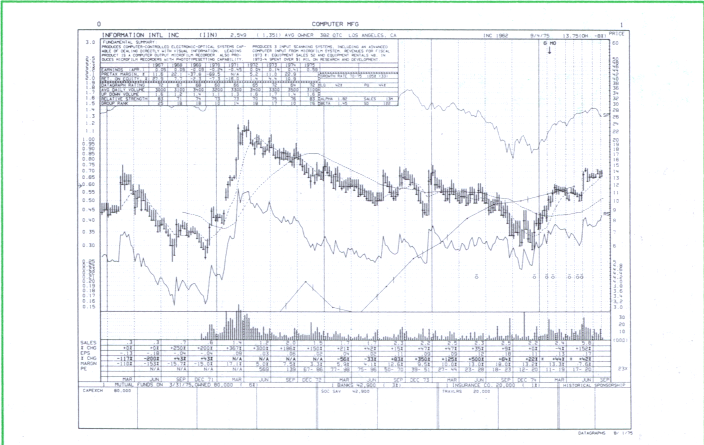
One branch of the military utilizes its FR 80 to produce microfiche masters containing more than 800 million pages annually, inventorying all its facilities and material. Each microfiche master contains up to 288 pages of data which are reduced 48 times from their original size. These 2.8 million microfiche masters are then used to create duplicate microfiche for the data management program. The duplicate fiche are distributed to various remote facilities to provide up-to-date cataloging while requiring only about 0.14% of the storage space of paper files.
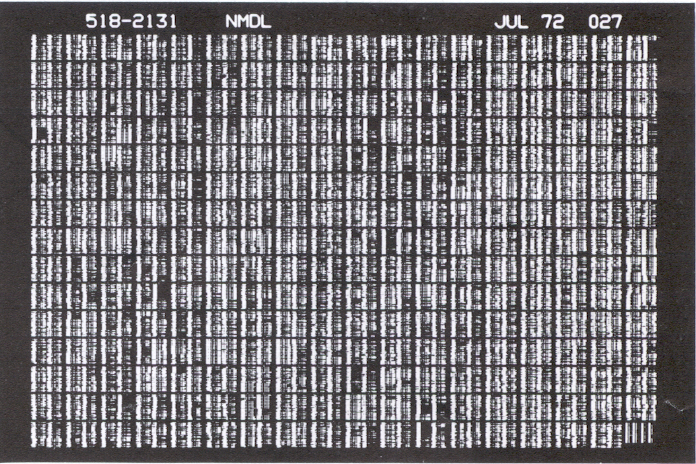
The FR 80 accepts as input 7-track, 800 bpi magnetic tape containing the inventory data. A title-extraction procedure places an eye-readable title on each fiche. The FR 80 writes each page, making up a fiche complete with form rules, and images the information onto film. Film is then automatically processed offline, producing the final microfiche master.
A major oil company utilizes the FR 80 to produce the many intermediate quick look seismic trace sections needed to check the quality of the data after its initial and subsequent passes through the computer. The FR 80 receives standard trace sequential tapes from the mainframe computer, interprets the data, and outputs a 24X reduction image on 35mm unsprocketed film. From the computer tape, the FR 80 can produce several run-time presentation options, including wiggle trace, variable area, variable density and wiggle/variable area. After the trace is recorded, the film is processed in Information International's 5010 Film Processor and enlarged to true size.
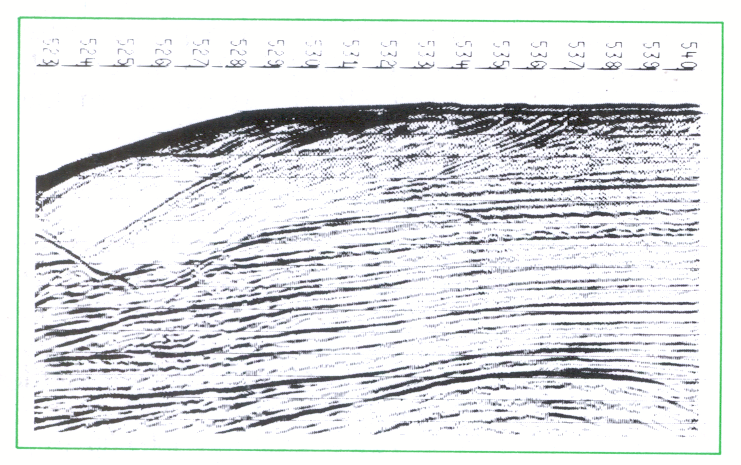
The FR 80 is a replacement for several types of mechanical plotters and can simulate any of these devices with a significant increase in throughput.
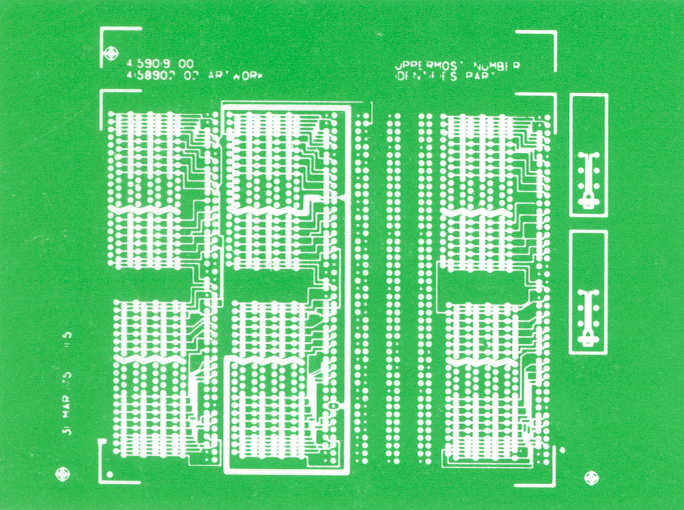
Electronic manufacturing companies use the FR 80 to produce high-quality engineering drawings on 35mm film and alphanumeric data on 105mm microfiche. The FR 80 also supports many types of plotting, including printed circuit board layout. In this latter application, the FR 80 assumes a major portion of the mechanical plotter workload, significantly improving drawing turnaround to users and reducing costs of drawings.
FR 80 Displayer allows the user the full range of FR 80 recording capabilities including point plotting, vector recording and character recording. The FR 80 Standard Data Format commands include 16,384 by 16,384 X -Y point plotting, vector drawing between selected end points, selection of solid, dotted or dashed vectors, and the drawing of arcs and circles of given arc length and radius.
GERBER Interpreter permits users to interpret most features of the GERBER automatic drafting machine, particularly as used in printed circuit board applications. (Due to variable formats available, program modification may be required for correct simulation.)
CalComp Interpreter interprets tapes formatted for series 500, 600 and 700 plotters and for the 900 series controller, at speeds up to ten times faster than mechanical plotter speeds.
4020 Interpreter interprets tapes formatted for the Stromberg DatagraphiX 4020 microfilm plotter.
META Interpreter interprets tapes created by IGS (Integrated Graphics System) subroutines for both graphic and alphanumeric data.
These accept most standard print tape formats including:
Forms Design Compiler enables the FR 80 to draw forms. Forms are designed directly from the console through use of the Forms Design Language and Compiler. Drawing the form on the CRT permits accurate placement of lines between adjacent characters without touching characters or losing print positions. Simple design commands permit the drawing of horizontal or vertical rules, automatic scaling of character header information, and even the creation of company logotypes.
Systems configured with a disc will be provided with the following programs:
COMpPRINT permits composition formatting of standard print image tapes. The user may selectively change font and character size for any field within the print page. Full microfiche titling, indexing and software forms design capabilities can be provided. Various editions of COMpPRINT will accept most line printer formats in common use, including IBM, UNIVAC, CDC, NCR, Burroughs and Honeywell.
COMpTEXT permits the user to record in IBM ATS archival format on the FR 80 for the initial generation and periodic updating of technical documents and business reports, using proportionally spaced type, which allows substantial savings in space and material. The user selects output font, character size and body leading. COMpTEXT automatically generates typeset outputs as specified by standard ATS formatting commands. The commands provide for tables or justified pages of text, complete with page headings and footnotes.
A variety of programs are available, either from Information International or other sources, to support the graphic capabilities of the FR 80.
Developed by the RAND Corporation, and available from Information International, IGS is a collection of Fortran subroutines which generate commonly used graphic constructs (lines, circles, display characters) and can be used to draw, label and title graphs. These subroutines produce output in META format which can be recorded on the FR 80 through use of the META Interpreter.
FRESCO, an acronym for FR 80 Extensions to SC 4020 Operations, was developed to take advantage of the advanced graphic features of the FR 80. Written in Fortran with some 360 assembly language, it is implemented under OS/MVT. The output of FRESCO is in FR 80 Standard Data Format. (Available from Information International through courtesy of Rockwell International.)
These Fortran routines can be used to produce 3D representations of engineering data plots. (Available from Information International through courtesy of Aerojet Nuclear Company, Aerojet-General Corporation.)
A versatile and highly flexible software system capable of virtually any type of data display including linear, semi-log, log-log, polar and map axis systems, 3D projections with or without hidden line removal, and a series of displays for business graphics. DISSPLA can be implemented on most mainframe computers and produces magnetic tape in many display device formats including FR 80 Data Format. (Available from Integrated Software Systems Corporation, P.O. Box 9906, San Diego, CA 92109.)
| INSTALLATION SPECIFICATIONS | |||
|---|---|---|---|
| Recorder and Translator |
Processor and Magnetic tape Control |
Magnetic Tape Unit |
|
| Weight | 385 kilograms (850 pounds) | 725 kilograms (1600 pounds) | 90 kilograms (200 pounds) |
| Recommended Service | 30A, 115V Single phase | 30A, 115V Single phase | |
| Power Cable Connector Required |
Hubbell Type 2610 | Hubbell Type 2610 | |
| Power Cable Supplied | 7.6 meters (25 feet) No. 10-3 Type SO rubber-covered with Hubbell No. 2611 caps |
7.6 meters (25 feet) No. 10-3 Type SO rubber-covered with Hubbell No. 2611 caps |
|
| BTU Output | 680kg-calories (2700 BTU) | 1740kg-calories (6900 BTU) | |
| ENVIRONMENTAL REQUIREMENTS | |||
| Temperature | 20°C to 22.7°C (68°F to 73°F) at the console. max. not to exceed 25.5°C (78°F) | ||
| Relative Humidity | 45% to 55% for optimum performance - max. limits 40% to 60% | ||
| Magnetic Interference | External fluctuating field shall not exceed 0.01 gauss | ||
| Vibration | Shall not exceed 10 hertz and a double amplitude of 0.01 inch | ||
